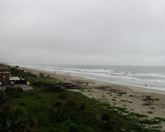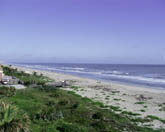December
19, 1999 - Flight Day 1 Launch Day
STS-103
Launch (Realplayer) 448Kb
Launch
Images
STS-103
Launch Replays (Realplayer) 1374Kb
Johnson
Space Center STS-103 Report # 01 - Sunday, December 19, 1999,
9 p.m. EST
Project
Update - 12/19/99 8:00 pm EST
Kennedy Space Center Space Shuttle Status,
December 19, 1999
 |
 |
 |
| 9:00
a.m. EST |
10:00
a.m. EST |
11:00
a.m. EST |
A
view of the Launch Site from Cocoa Beach on Launch Day, December
19, 1999.
The
Space Shuttle Discovery was successfully launched at 7:50
pm EST, precisely on time for the start of the planned launch
window. This beautiful and flawless evening launch marks the
start of the Hubble Space Telescope Servicing Mission 3A.
With
this launch time, the astronauts' days will start at around
10 am EST, and extend to around 2 am EST, daily. Rendezvous
and berthing with the Hubble Space Telescope will take place
from 1:45 pm to 11:00 pm on Tuesday, December 21. The EVA
"space walks" will start at roughly 2:50 pm EST and last approximately
6 hours, starting on Wednesday, December 22. We are currently
planning on reducing the number of EVAs from 4 to 3 in order
to accommodate the delayed launch date. This will allow for
returning the Shuttle in advance of the millenium rollover
under all landing contingency cases.
The
optional tasks on EVA day 4 involve preventive maintenance
to the Hubble's external "space blankets". Some of these can
be worked into the existing EVA days, or rescheduled for a
later Servicing Mission. We have not seen, nor do we expect
to see, any immediate performance degradation from Hubble's
blankets, which help to maintain the internal temperatures
of the observatory.
Kennedy
Space Center Space Shuttle Status, December 19, 1999
MISSION:
STS-103 - 3rd Hubble Space Telescope Servicing Mission
VEHICLE: Discovery/OV-103
LOCATION: On orbit
OFFICIAL LAUNCH DATE/TIME: December 19 at 7:50 p.m. EST
TARGET LANDING DATE/TIME: December 27 at about 5:24 p.m. EST
MISSION DURATION: about 7 days, 21 hours and 34 minutes; with
3 EVAs
CREW: Brown, Kelly, Smith, Foale, Grunsfeld, Nicollier, Clervoy
ORBITAL ALTITUDE and INCLINATION: 317 nautical miles/28.45
degrees
Work
in progress: Space Shuttle Discovery and a seven-member flight
crew lifted off from KSC's Launch Pad 39B on time at 7:50:00:069
p.m. today. The launch team worked no significant issues during
the launch countdown and weather conditions were excellent
at launch time. Discovery has embarked on its 27th space flight.
Discovery and crew will rendezvous with the Hubble Space Telescope
on Tuesday afternoon for a berthing of the spacecraft in the
orbiter's payload bay Tuesday night. Three space walks are
planned during this mission to accomplish planned Hubble servicing
efforts. Discovery returns to earth Monday, Dec. 27 at about
5:24 p.m. EST.
The
solid rocket booster recovery ships, Liberty Star and Freedom
Star, deployed from KSC on Wednesday, Dec. 15. They are expected
to arrive at Hangar AF with boosters in tow tomorrow at about
4:30 p.m. EST.
Johnson
Space Center STS-103, Mission Control Center
Status Report # 01
Sunday,
December 19, 1999 - 9 p.m. EST
In the final launch attempt available this year, Discovery
and its seven astronauts blasted off tonight on the last human
space flight of the 20th century to refurbish the Hubble Space
Telescope.
Under clear and starry skies at the Kennedy Space Center,
Discovery lifted off on time at 6:50 p.m. Central time, lighting
up the Central Florida coastline, to send Commander Curt Brown,
Pilot Scott Kelly, and Mission Specialists Steve Smith, Jean-Francois
Clervoy, John Grunsfeld, Mike Foale and Claude Nicollier on
a two-day chase to catch up to and retrieve the 12 and a half
ton telescope. Hubble was sailing over Eastern Africa at the
time of launch.
Eight and a half minutes after the third and final shuttle
launch of the year, Discovery was in orbit as its crew members
began to configure shuttle systems for the planned 8-day mission.
One rendezvous burn of the reaction control system jets is
planned before the crew goes to sleep early Monday to fine
tune Discovery's path to catch up to Hubble.
Technically, Hubble has been in hibernation since the loss
of a fourth gyroscope on November 13 designed to enable the
telescope to point precisely at distant astronomical targets
for scientific observations. Hubble is in what is known as
"safe mode", a state of dormancy in which the telescope
aims itself constantly at the sun to provide electrical power
to its systems. Hubble is scheduled to be captured by Discovery's
robot arm around 6:40 p.m. Central time Tuesday.
Once the crew retrieves Hubble, it will be parked at the rear
of Discovery's cargo bay so that two teams of space-walking
astronauts can perform repairs and upgrades to its systems
during three nights of space walks. The most vital of the
space walks will occur on Wednesday night, when Smith and
Grunsfeld replace all six of Hubble's gyroscopes and install
devices to improve voltage regulation to the telescope's systems.
Only three space walks are planned because the mission was
shortened. Smith and Grunsfeld will conduct the first and
third space walks, while the second will be conducted by Foale
and Nicollier.
If all goes as planned, Hubble will be released back into
orbit on Christmas Day around 5 p.m. Central time, with landing
planned on Dec. 27 at 4:24 p.m.. Central time at the Kennedy
Space Center.
The astronauts are scheduled to begin an eight-hour sleep
period at 1:50 a.m. Central time Monday and will be awakened
at 9:50 a.m. Central time to begin their first full day in
orbit.
Discovery is orbiting the Earth at an altitude of about 300
nautical miles, completing one orbit of the Earth every 90
minutes.
The next STS-103 mission status report will be issued shortly
after crew wakeup Monday morning.
|